This courgette spaghetti (that’s “zucchini” spaghetti or “zoodles”, for my US friends!) from Annabel Karmel is deliciously flavourful and you won't feel like you're missing out on standard, carb-based pasta at all.
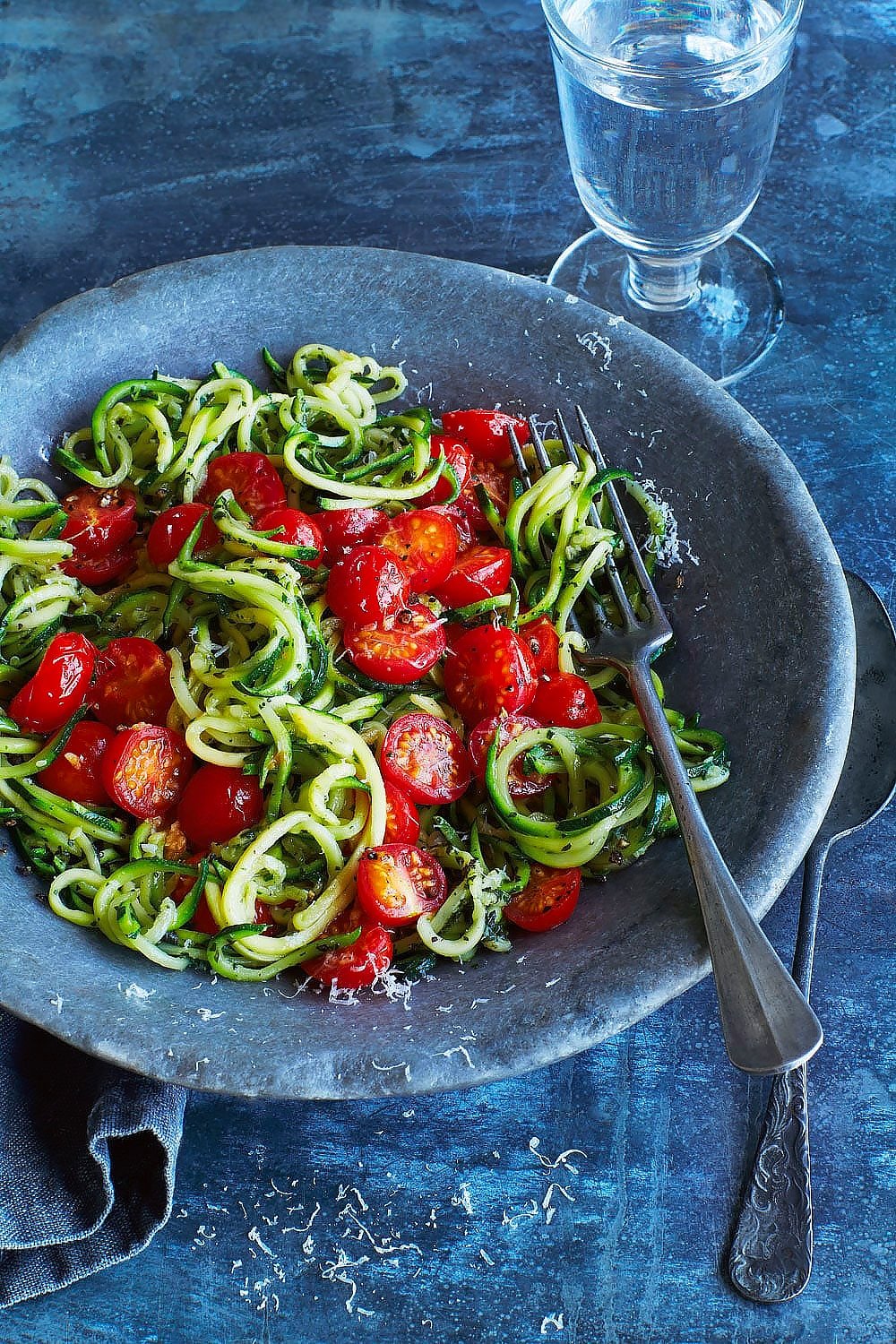
It's from Annabel's cookbook, Busy Mum's Cookbook, which is full of great family-friend recipes.
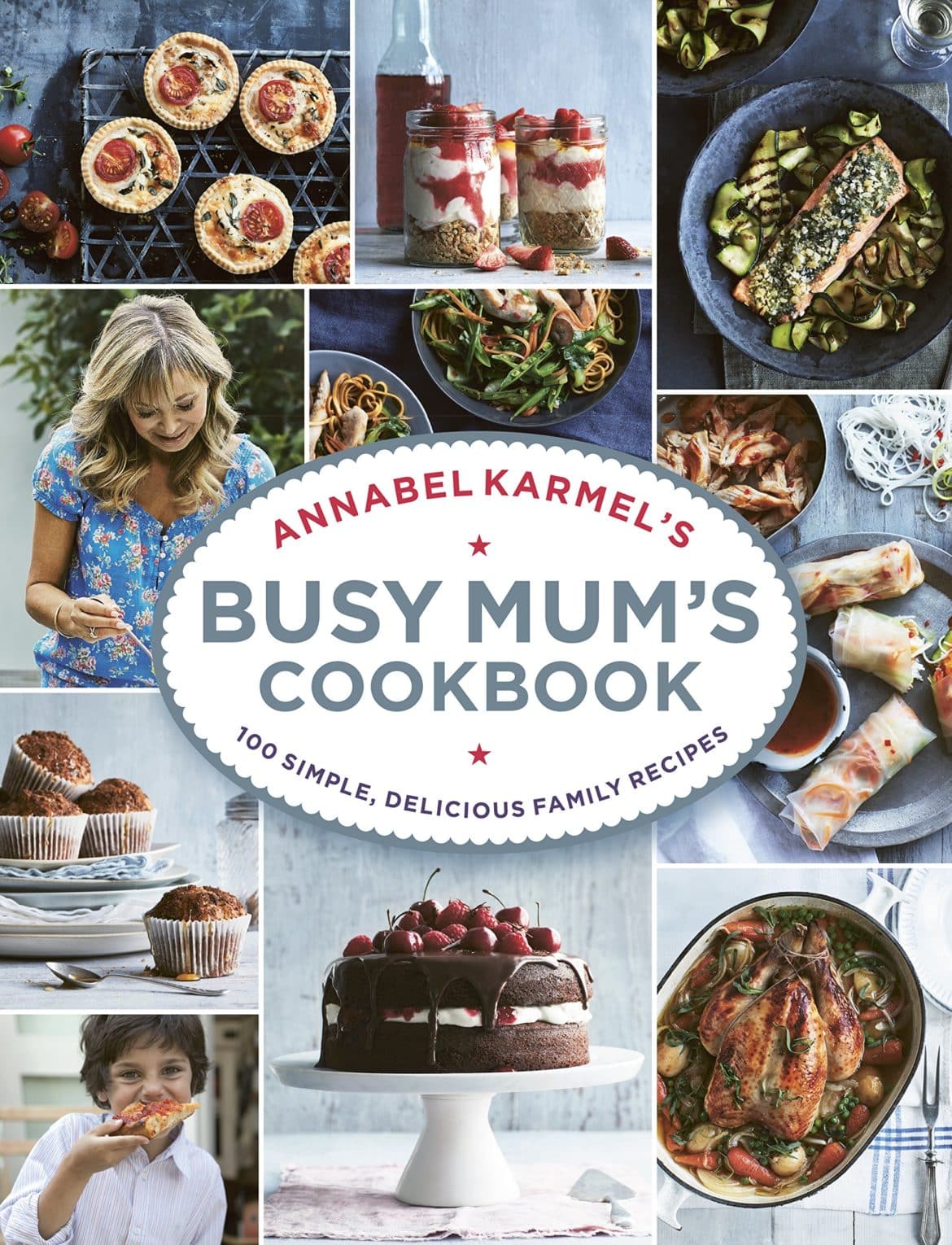
Annabel Karmel's courgette spaghetti is a brilliant alternative to traditional spaghetti, full of vegetables and with a wonderfully smooth taste.
The courgette is lightly pan-fried which means it retains a little crunch - perfect when contrasted to the succulent tomatoes that burst in your mouth with flavour.
It makes for a delicious and low carb meal with a unique texture that I'm sure you'll enjoy.
I had great fun helping Annabel make this recipe, and although I've made courgetti with a spiraliser before, this is the tastiest dish recipe I've tried.
Here's how to make this courgette spaghetti.
Ingredients
- 4 courgette (zucchini) large
- 3 tbsp olive oil
- 2-3 cloves (2-3) garlic crushed
- 250 g (1¼ cups) fresh cherry tomatoes halved
- 2 tbsp fresh green pesto
- 50 g (½ cup) Parmesan or vegetarian hard cheese alternative grated/shredded
- pinch salt and black pepper
Instructions
Put the courgettes through a spiraliser to make long spaghetti-like strands.
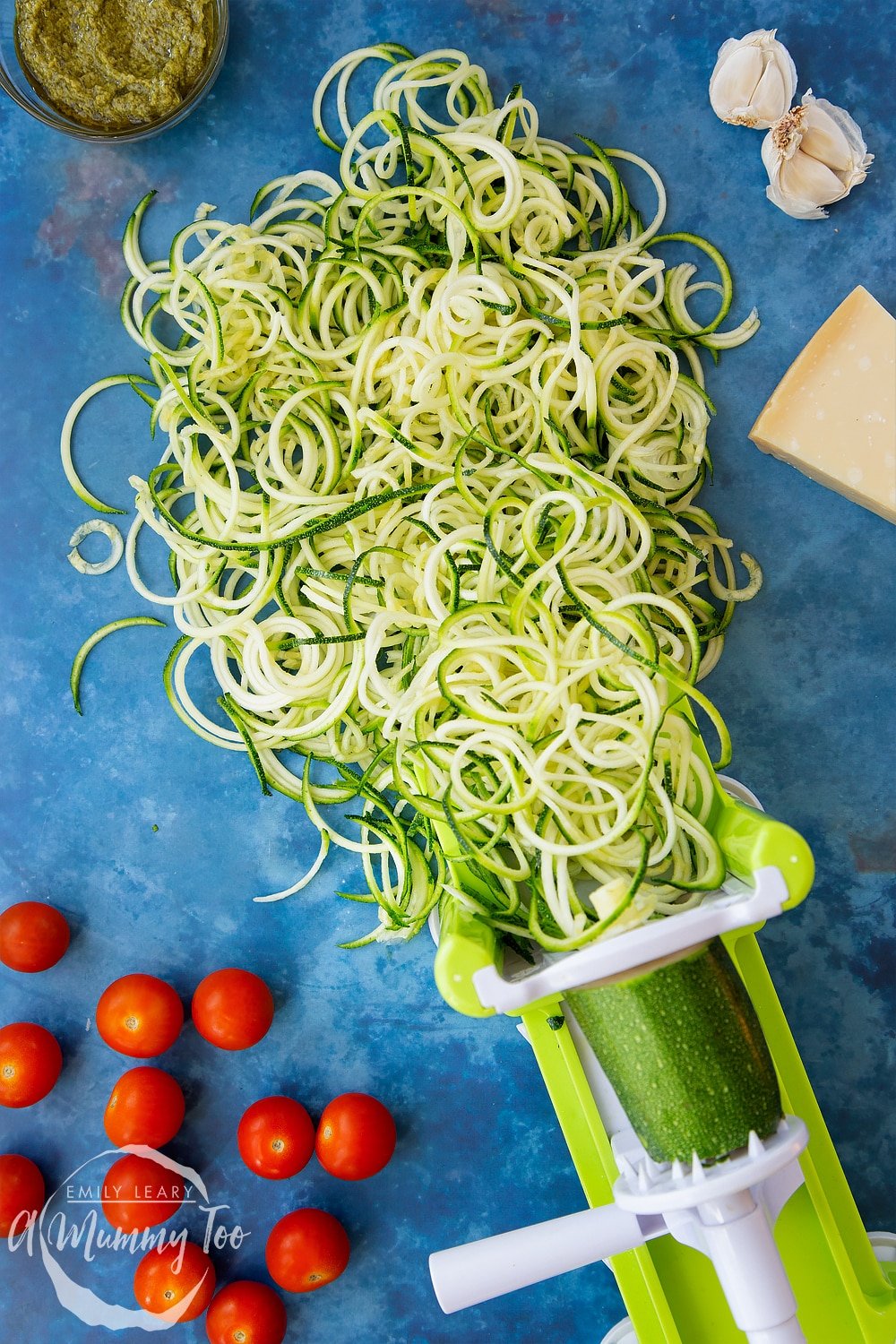
Heat 2 tablespoons of the olive oil in a large frying pan over a medium heat. Add the garlic.
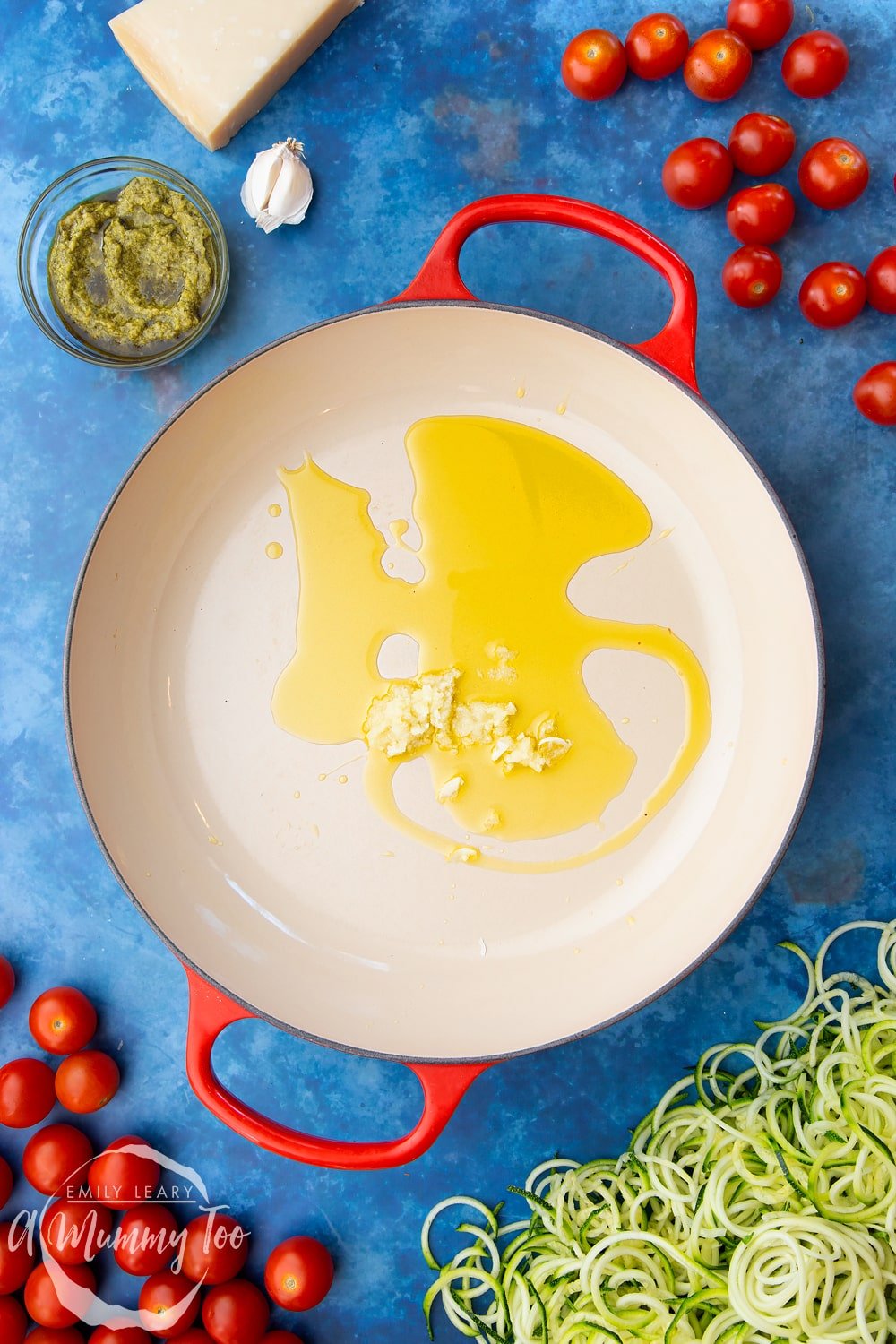
Fry for a few seconds.
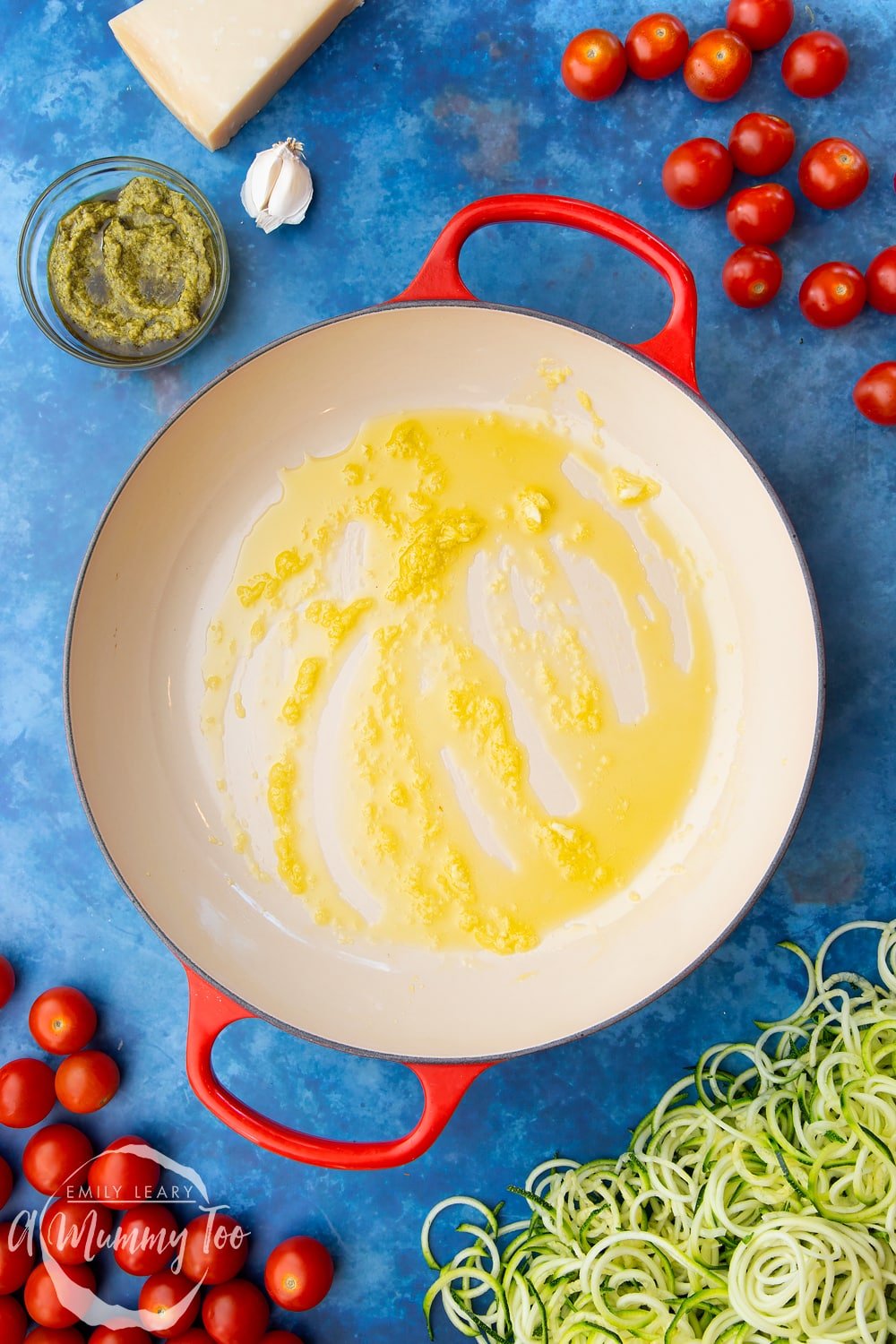
Add the spiralised courgettes to the pan.
Toss over a high heat for 2-3 minutes, until just softening, then remove and set aside on kitchen paper.
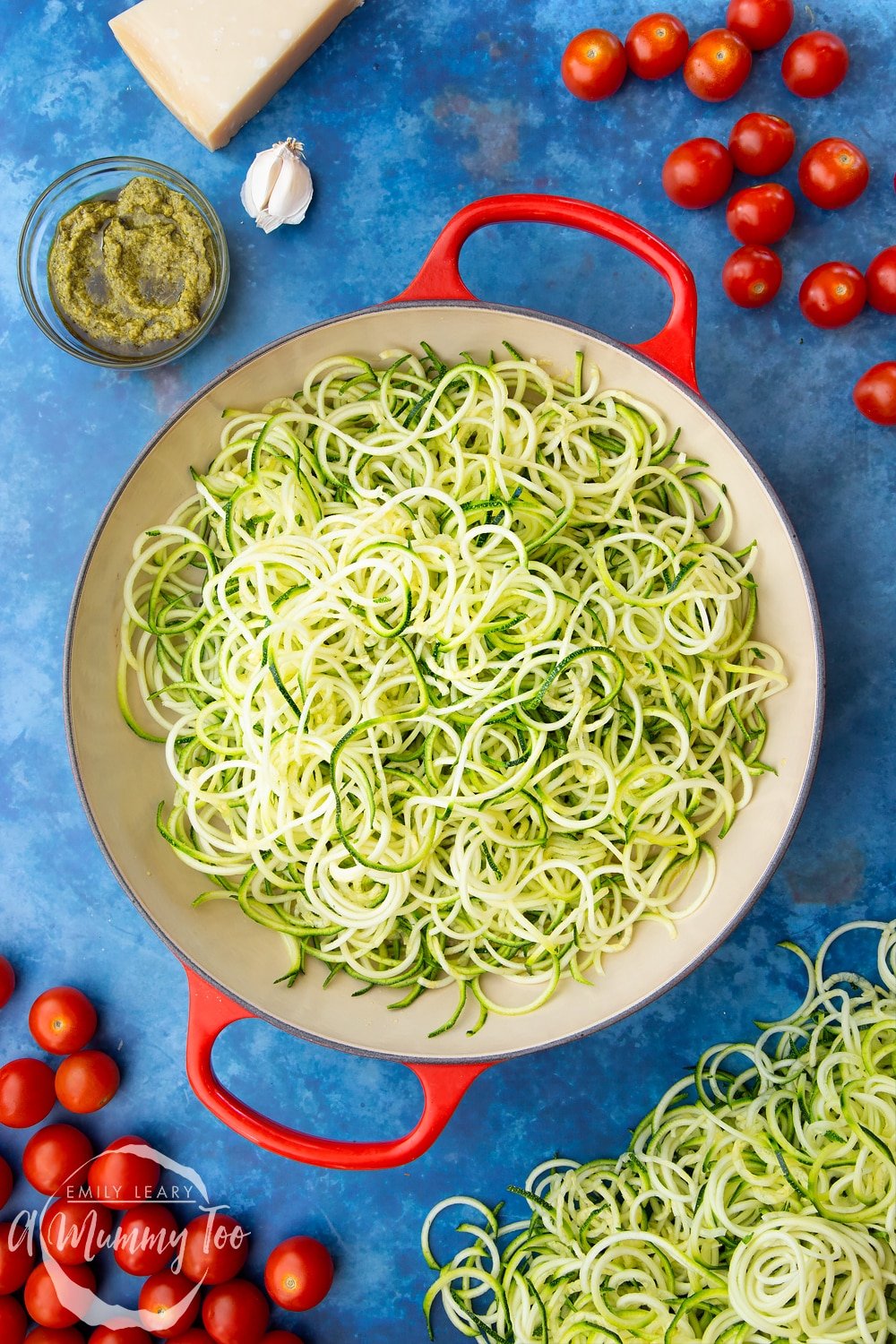
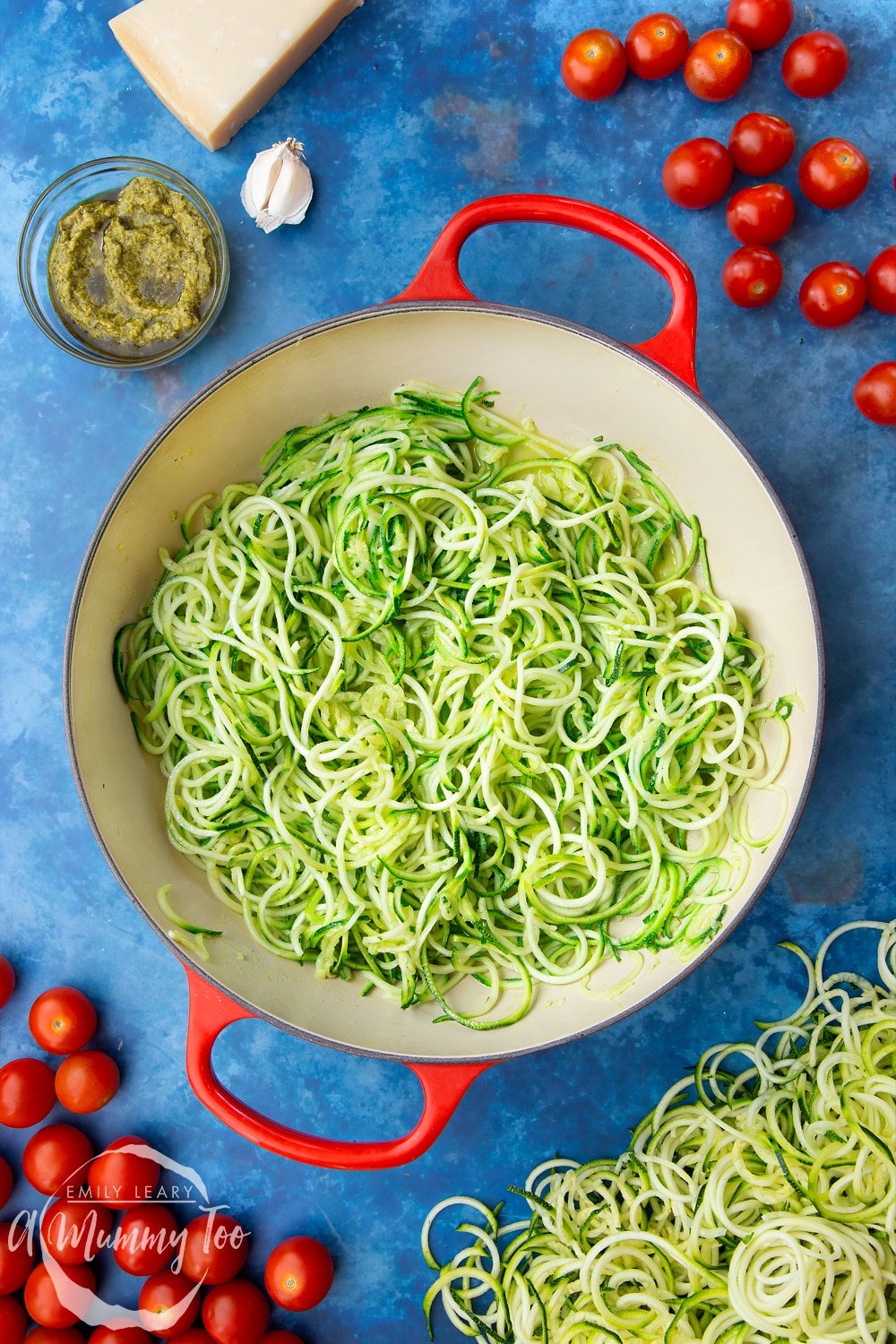
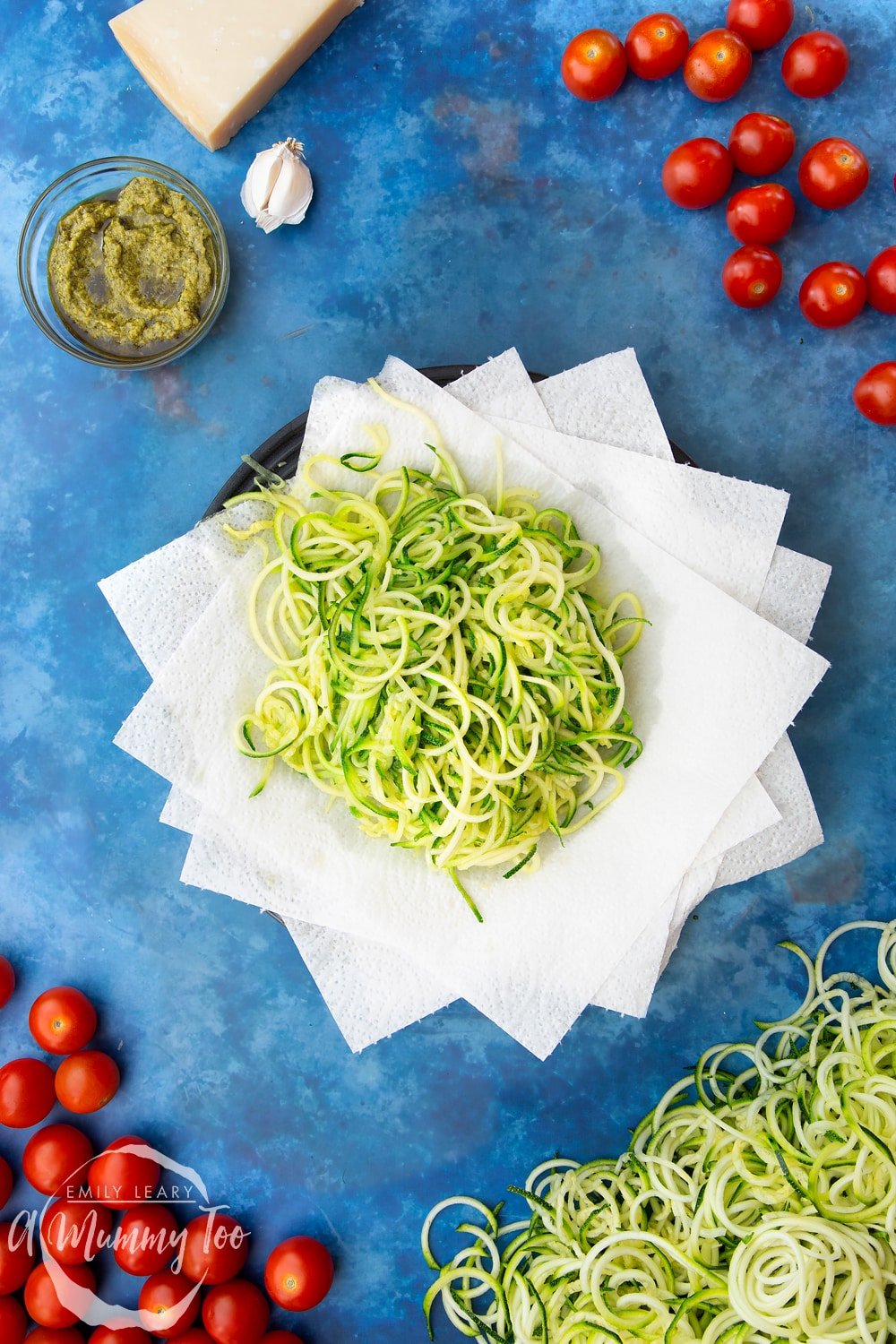
Return the frying pan to the heat, add the remaining olive oil.
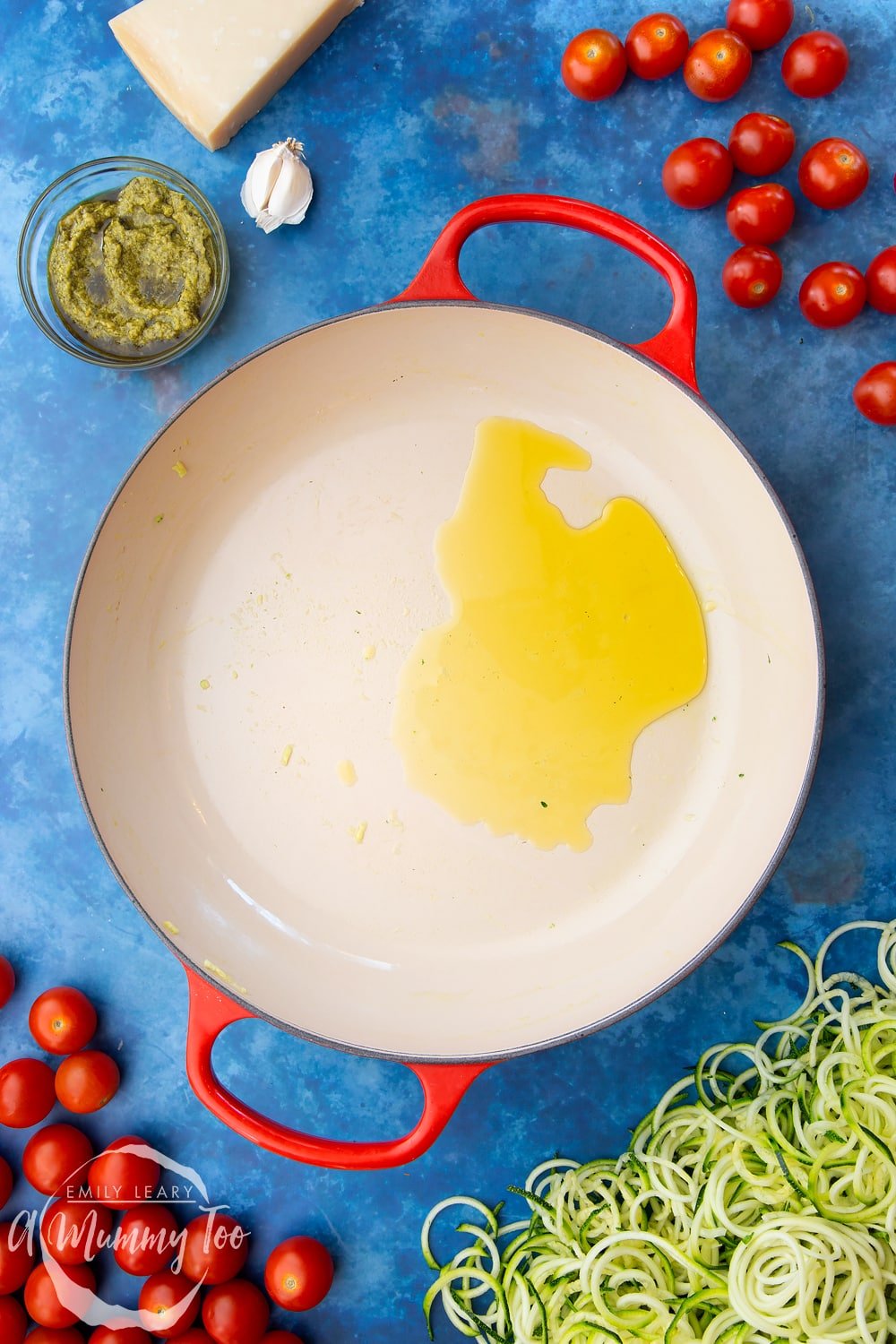
Fry the tomatoes for 2 minutes.
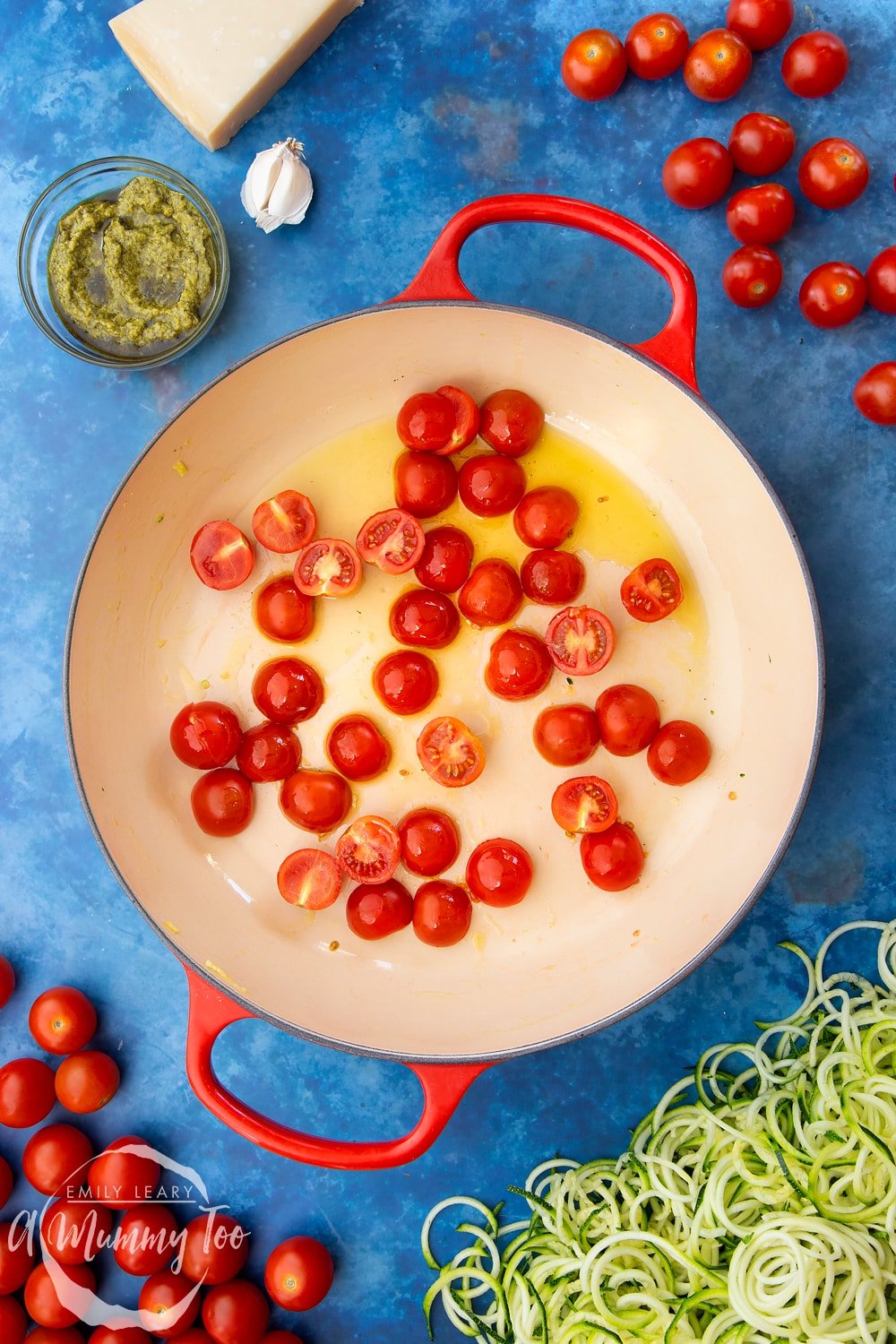
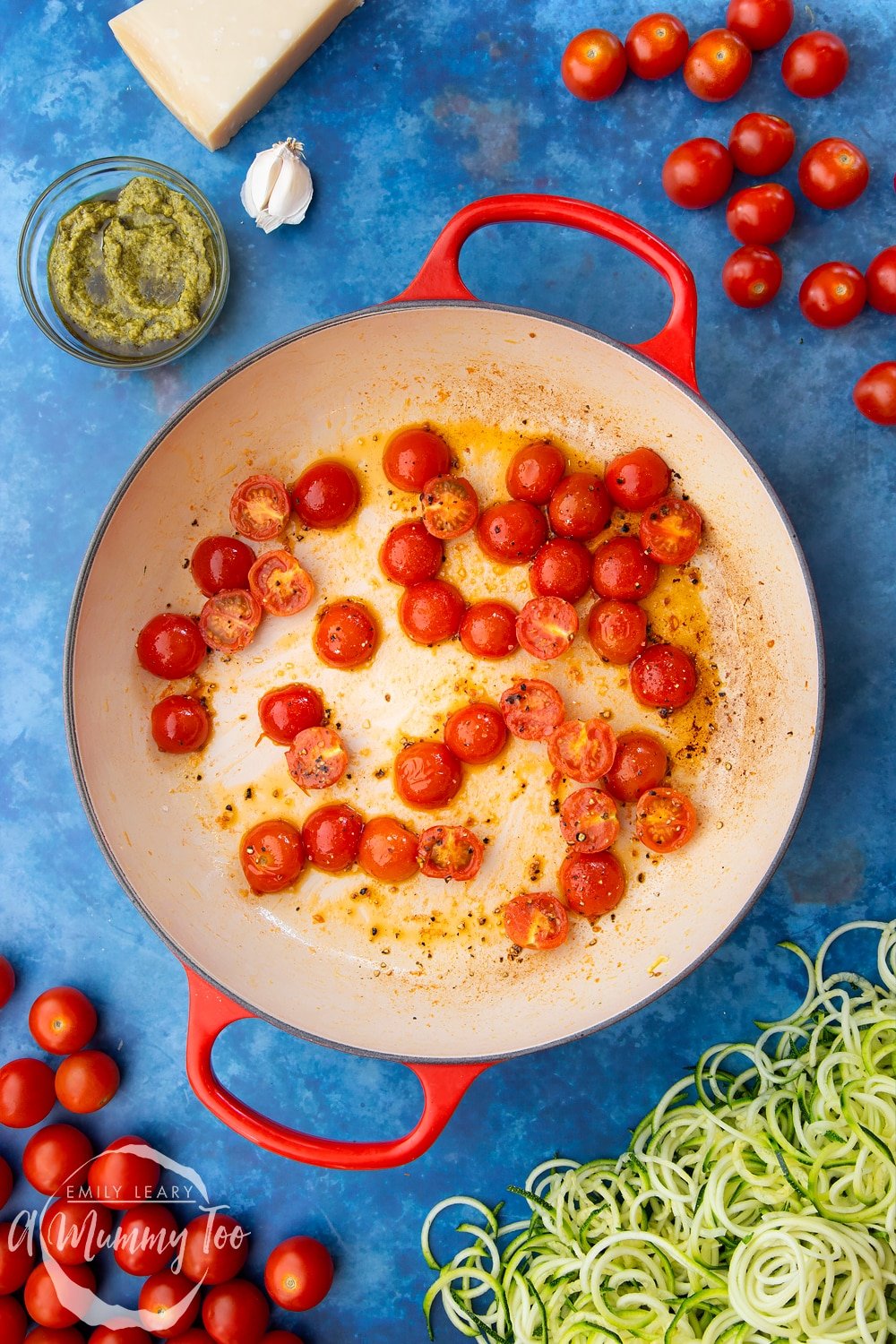
Season, add the spiralised courgettes, pesto and grated Parmesan. Note from Emily: I find that I don’t always need all of the parmesan and pesto, so I would recommend adding half, stirring through and then adding the rest if needed.
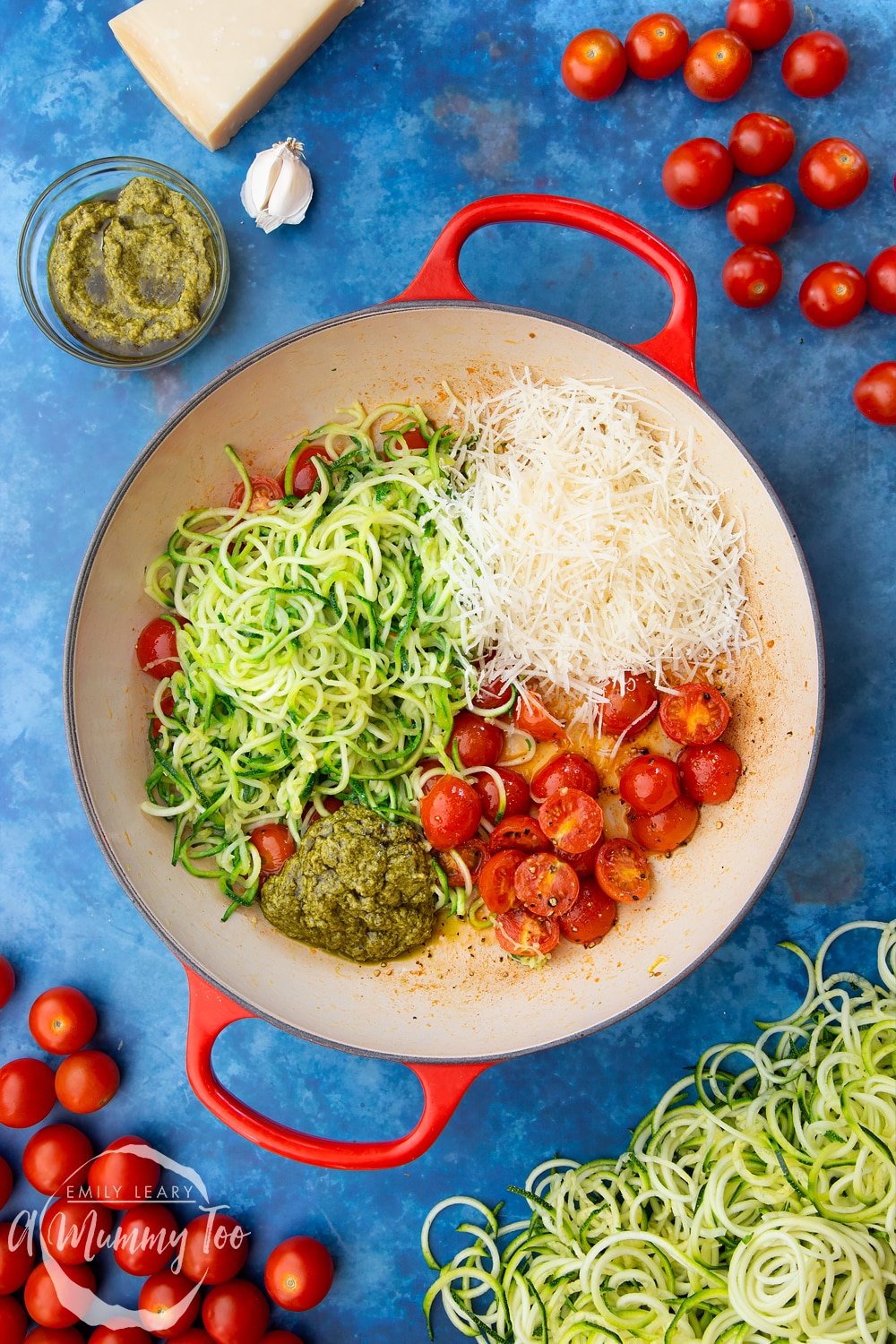
Toss until heated through and serve immediately.
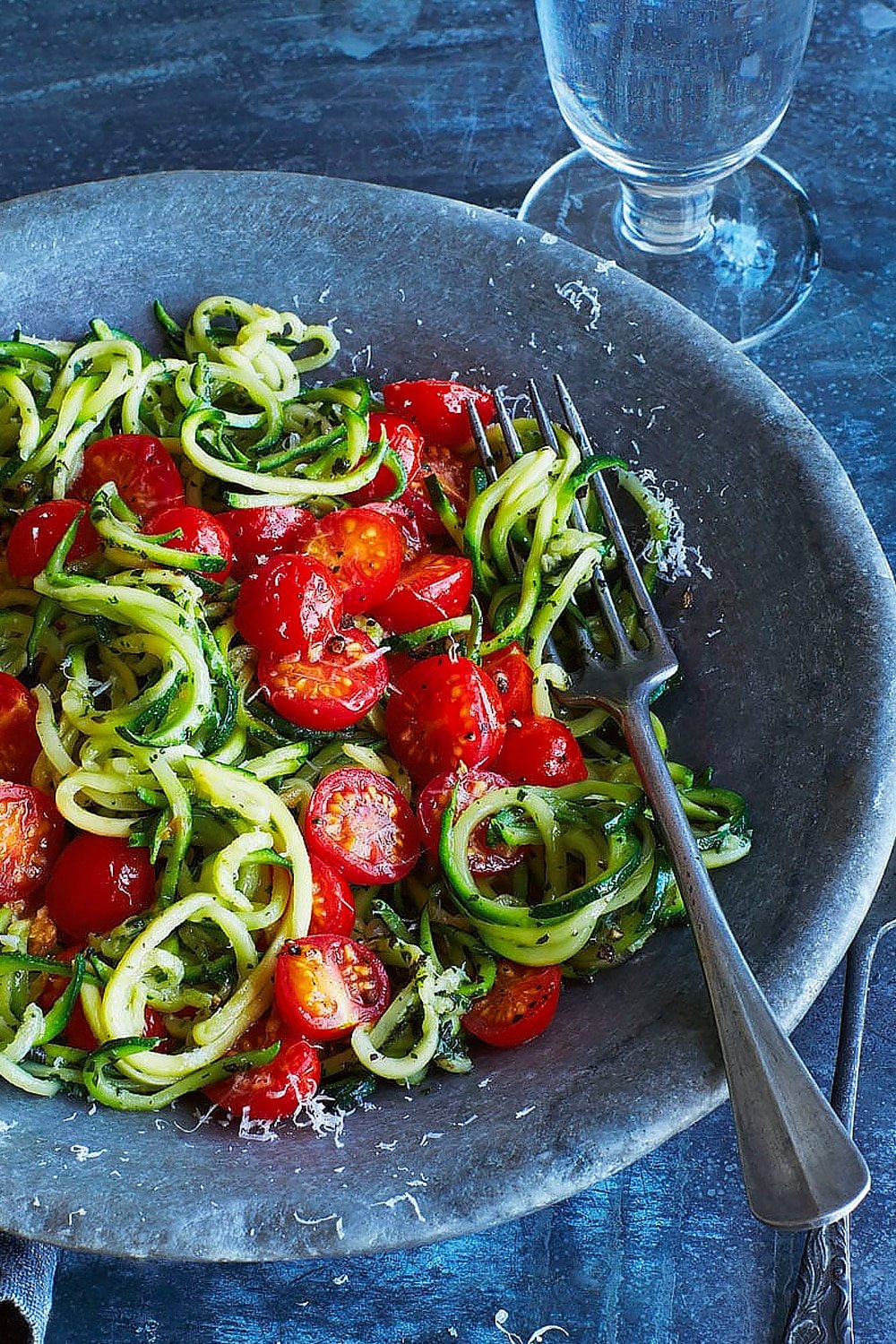
Now hop over to watch my interview with Annabel and learn more about her amazing career so far.
Have you tried courgette spaghetti before?
Pointers, tricks and troubleshooting tips for the perfect courgette spaghetti
Do I need a spiraliser to make courgette spaghetti?
A spiraliser is the ideal tool as it does the job quickly and efficiently, giving you lovely long strands of a consistent thickness.
If you don't have a spiraliser, a julienne peeler or mandoline with the correct blade will work, although the strands won't be as long.
A sharp knife and plenty of patience would also do the job in a pinch, and although the strands would be shorter, it might be an excellent way to explore if you like the taste and texture before investing in a specialist tool.
Is courgette spaghetti easy to make?
If you have a spiraliser, this courgette spaghetti recipe is so easy to make that you'll be tempted to make it every day!
All you need to do is chop the garlic and add it to some oil in a heated pan. Then add your spiralised courgette and quickly cook; then rest the courgette briefly on some kitchen roll while the tomatoes cook. Once your tomatoes are cooked to your liking, simply add the remaining ingredients, mix and cook for a couple of minutes before serving. Best of all? The whole process should take less than 10 minutes.
Annabelle's recipe is super easy to follow, but if you get lost, I've included some step by step photos so you can see exactly how your recipe should look.
Are there other names for courgette spaghetti?
Now there's a can of worms! Parts of the English speaking world, including the UK, call the beloved long green summer squash a courgette. Meanwhile, other parts, including the USA, call it "zucchini".
As a consequence, courgette spaghetti goes by a variety of alternative names.
I've seen it called:
- 'courgette spaghetti
- 'courgette'
- 'courgette spaghetti
- 'zucchini spaghetti'
- 'zucchini noodles'
- 'zoodles'
- 'Kevin' (not really - I made that one up!)
Will I need any special equipment to make courgette spaghetti?
The only special equipment you'll need for this recipe is the spiraliser.
Everything else you should already have in your kitchen (pan, utensils, knife, chopping board). Luckily spiralisers are easy to find and relatively inexpensive.
There's always a complete list of suggested equipment on the recipe card below my recipes if you're in doubt. In addition, I always include links to example products to show exactly what I used to make each recipe.
How can I tell if parmesan cheese has gone off?
As Parmesan cheese gets older, it starts to dry out, crack and turn a darker colour.
When cheese spoils, it tends to develop a more intense aroma. For example, Parmesan already has a smell, but it has probably gone bad if it smells 'tangy' or acidic. This tangy smell is caused by lactic acid, which is produced when bacteria break down the fat and protein in the cheese. So it's a telltale sign that your cheese is off.
Parmesan becomes hard as it loses water content, so you should always store it in a sealed container to help keep the water content longer.
As Parmesan begins to get spoiled, it will develop mould spots. Many kinds of cheese contain mould, though it's cultivated and monitored to ensure that it's safe. However, the mould on white cheeses at home isn't suitable for eating as it could contain harmful bacteria.
So if your Parmesan looks a different colour, has cracks and dryness, smells different or has spots of mould, you should discard it immediately. You should also wash anything it has come into contact with (utensils, bowls etc.)
Is courgette spaghetti suitable for vegetarians?
Parmesan cheese usually contains animal rennet, but if you use a vegetarian hard cheese, your courgetti will be completely vegetarian.
Manufacturers use animal-derived products to thicken, colour and flavour many types of foods, meaning it can sneak into the most surprising ingredients!
So always make sure that you double-check ingredients labels to ensure that they are vegetarian.
Also, don't forget to check anything extra you intend to serve with your courgetti. For example, salad dressings can sometimes contain anchovy.
Is courgette spaghetti suitable for vegans?
To make this dish vegan, you only need to substitute the Parmesan cheese for a vegan cheese that grates well.
At the time of writing, Violife Vegan Prosociano Wedge is available in many UK and Western Europe supermarkets. However, you will probably be able to find other brands and varieties in vegan or health food stores.
You should always double-check all of your ingredients labels to ensure that they are vegan. Also, don't forget to check anything extra that you intend to serve with your recipe.
Is courgette spaghetti gluten-free?
Yes, this dish is gluten-free, as long as you make sure to use gluten-free pesto or make your own.
Double-check your ingredients labels to make sure that they're gluten-free. Also, don't forget to check anything extra you intend to serve with your courgetti, like salad dressings or sauces.
Is courgette spaghetti keto-friendly?
This dish should be keto-friendly, as courgettes are considered low in net carbs. Also, Parmesan and oil are suitable for keto. So as long as you use a keto-friendly pesto, the only issue would be the tomatoes.
Tomatoes contain natural sugar and carbohydrate, so you should watch your portion size if you follow a keto diet. For example, you could reduce the number of tomatoes and supplement a keto portion with more rocket.
Is courgette spaghetti healthy?
Yes. This recipe is pretty low in carbs and is almost entirely vegetable. There are many documented health benefits to eating green veg, garlic, tomato and olive oil.
So as long as you have no allergies, you can consider this meal a healthy and delicious feast.
Is courgette spaghetti safe to eat while pregnant?
Yes. There are no ingredients in this recipe that would pose a risk to a pregnant person.
So as long as you make sure that all of your ingredients are fresh and you prepare them safely and hygienically, this meal will be a perfect treat for a pregnant person.
A Mummy Too does not offer medical advice. Please seek help from a medical professional if you need further information or have any concerns.
What goes well with courgette spaghetti?
I think this recipe has the perfect balance of sharp and sweet. Though serving it with a nice glass of wine could make it even better!
Can I leave out the pesto?
You'll still get delicious courgette spaghetti if you leave out the pesto.
If you want to try something different, you could substitute a little pasta sauce or perhaps some cream cheese.
Can I make this courgette spaghetti without tomatoes?
Sure! If you don't like cherry tomatoes or haven't got any in the refrigerator, you could leave them out entirely or try sundried tomatoes or chopped sweet peppers.
Again, different vegetables release different amounts of water as they cook so that you may get a different consistency to your finished sauce.
If you aren't a fan of tomatoes, you could even swap out the tomatoes for some pitted olives. However, olives will make the dish a little saltier, so keep that in mind.
Why did my courgette spaghetti go soggy?
You must only cook the spiralised courgette briefly before transferring it to some paper towels to drain.
These two steps are vital to ensuring you don't end up with wilted, overly soft noodles.
Can courgette spaghetti be eaten raw?
Courgette noodles are great, totally raw when complemented with the right flavours. Please put them in a salad with a tart vinaigrette. Heaven!
Or use them raw in place of any dish where you'd usually use cooked wheat pasta - it works surprisingly well!
Can this courgette spaghetti be boiled, microwaved or put in the oven?
This dish is best heated in a pan with oil and eaten immediately.
You could try boiling or microwaving your spiralised courgette, but it will cook very quickly and turn out watery and soft at best. At worst, it will disintegrate and fall apart.
So if you do try boiling or microwaving it, you should only cook it very briefly and drain it well. A sieve lined with a piece of kitchen towel would probably work best.
If you cook it in the oven, it's likely to dry out quickly and become more like courgette crisps.
So for best results, cook it briefly in the pan as the recipe describes.
What can I use instead of courgettes?
Butternut squash noodles, also known as 'boodles', could work well in the recipe. Just make sure the noodles are sufficiently cooked.
Other squashes will work well too, or even root veg such as carrot or sweet potato.
When experimenting with different vegetables in this recipe, you might need to add a splash of water towards the end of the recipe to loosen the sauce.
Let me know which works for you!
Can I make the courgette spaghetti without pesto?
You can make the dish without pesto, but there won't be as much flavour. The texture will be a little less oily too.
Pesto works well for this recipe because it has a lower water content than pasta sauce. So pesto doesn't make the courgetti too soggy, as courgette is very high in water.
So if you use something instead of pesto, bear in mind that it shouldn't be a very wet sauce.
What's the difference between red pesto and green pesto?
Pesto is usually made using a base of parmesan cheese, ground pine nuts (or other nuts), olive oil and crushed garlic.
You can add to this base to flavour pesto however you prefer. For example, you can make chilli pesto, wild garlic pesto or even pink beetroot pesto!
Red pesto is made using sundried tomatoes and red peppers, whereas green pesto is made with spinach. So that's the difference between the two.
Where did you get the spiraliser?
You won't usually find a Spiraliser in a supermarket. So you might have to look online or in specialist kitchenware stores. This spiraliser from Amazon is an excellent compact version that would be easy to store.
Alternatively, I find that TK Maxx (TJ Maxx) has tons of them in the kitchenware section.
How should I store my courgette spaghetti?
This courgette spaghetti is so delicious fresh from the pan. Luckily it's super quick to make - it takes under 10 minutes to prepare and cook! So I think it's best to make it as you need it.
If you want to save any leftovers, it's also super delicious cold as a sort of salad. Or you can reheat it too.
The best way to store leftovers is in the fridge, as directed below.
However, I wouldn't recommend freezing it due to the high water content in the courgette.
How long will courgette spaghetti keep?
If you make sure your courgette spaghetti is well-drained and stored in an airtight container in the fridge, it should keep for up to 3 days.
Can I leave courgette spaghetti out on the counter?
No, the Parmesan in the recipe will quickly spoil if you leave your courgette spaghetti out on the counter. So it's best to keep it in an airtight container in the fridge.
Can I make courgette spaghetti ahead?
You can make your courgetti a day ahead, but I wouldn't advise it.
It's challenging to reheat your courgette spaghetti without the courgette disintegrating or turning mushy.
Luckily the recipe only takes 5 mins to prep (when spiralising) and 6 minutes to cook!
Can I keep courgette spaghetti in the refrigerator?
Yes, the best place to keep this courgette spaghetti is in the fridge in an airtight container. As I said, it will keep for up to 3 days in the fridge. However, it will be at its best within a day or so of cooking.
Can I freeze courgette spaghetti?
I wouldn't recommend it. The high water content of courgette and tomato would mean the water in the plant cells would expand when frozen and destroy the cell walls. So when you defrost it, you'll most likely end up with a weird looking mushy mess.
Can fresh, uncooked courgette spaghetti be frozen?
While you can get away with freezing freshly spiralised courgette, I'd recommend against it.
Freezing uncooked vegetables causes ice crystals to form, which puncture the walls of the plant cells. These then release water while thawing, making the veg lose their crunch and seem mushy.
However, if you have accidentally made far too much, put the freshly spiralised zoodles in a ziplock bag, freeze them, and then drain off the excess liquid once thawed for the best possible results.
Can I make courgette spaghetti in a different quantity?
Sure! If you want to make more or less of this recipe, go ahead. This recipe serves 4 (or makes 4 adult-sized bowls). So, for example, if you're cooking for two, just half the ingredients.
This recipe uses 4 courgettes, so we can assume that one mid-sized courgette is enough for a one-person portion.
As for the rest of the ingredients, you can divide them by 4 to give you a one-person portion. Then make as many portions as you like from there.
However, some elements (like the garlic) are an approximation, as it's up to you how garlicky you like your courgetti to taste.
Can I make courgette spaghetti in a stand mixer like a KitchenAid or Kenwood Mixer? Or can I use a food processor?
Nope! There's no point in this recipe that would require a stand mixer or food processor.
How can I make sure my courgette spaghetti turns out perfectly?
The two key points to getting perfect courgetti are prep and cooking.
- Getting consistent courgetti strands is essential. For example, if you have thick and thin pieces, they will cook differently. So the thin pieces will burn before the thicker pieces are cooked. So it's best to use a spiraliser to avoid having uneven sized courgetti strands.
- Cooking time is the other key point. If you undercook your courgette spaghetti, the water won't evaporate, leaving you with wet, soggy courgetti. On the other hand, you don't want to overcook the courgetti, or it will become mushy and fall apart. Or it could burn if you cook it for a very long time. So make sure you set a timer once you add it to the pan to take the guesswork out of the process.
Why did my courgette spaghetti turn out dry/burnt?
If your courgetti turned out dry or burnt, then it sounds like you have overcooked your courgette pasta.
It only takes 6 minutes on medium heat to cook this dish. So make sure your hob isn't turned up too high and that you set a kitchen timer when cooking this dish.
Why did my courgette spaghetti turn out wet/mushy?
If your courgetti is wet, it sounds like you forgot to dry it on the kitchen towel. As the courgette cooks, it releases water. Resting it on a kitchen towel (step 4) will allow the excess liquid to absorb into the kitchen towel. So don't skip that step!
If your courgette pasta is really mushy, you may have overcooked it. So it's crucial you follow the cooking time as the recipe states, so you don't end up with mushy courgetti.
How can I add/change the flavours in this courgette spaghetti?
If you want to add or change flavours to this recipe, you could do a few things.
- For extra greenery, you could soften a few handfuls of spinach in the pan for 2-3 minutes before adding the courgetti. Make sure you cook off the excess water from the spinach, or your courgetti might get soggy.
- You could add some dried chilli flakes or a drizzle of chilli-infused olive oil for a kick of heat.
- You could use a different kind of pesto for a completely different flavour profile. As I mentioned earlier, there are many kinds of pesto, from red pepper to beetroot and even pumpkin. So feel free to experiment. You can use other pesto in the same quantity as the green pesto in the recipe.
- If you can't get your hands on courgettes, spiralised butternut squash should work just as well, though it will need a little extra cooking time (you'll have to judge by tasting it while cooking).
Where is the origin of courgette spaghetti?
Courgette spaghetti is a low carb alternative to pasta which doesn't sacrifice flavour, so it's easy to see how it's so popular.
Thanks to Stanley Tucci's cooking show featuring a courgette and spaghetti dish, courgetti has recently had a resurgence with people looking for a low carb or gluten-free version.
But who created actual courgette based zoodles? It seems the dish originated from a food blogger from New Jersey called Ali Maffucci. Maffucci is known for recipes utilising spiralisers. Her dishes include savoury recipes like spiralised courgette and shrimp pad thai and even spiralised desserts like a pear with yoghurt.
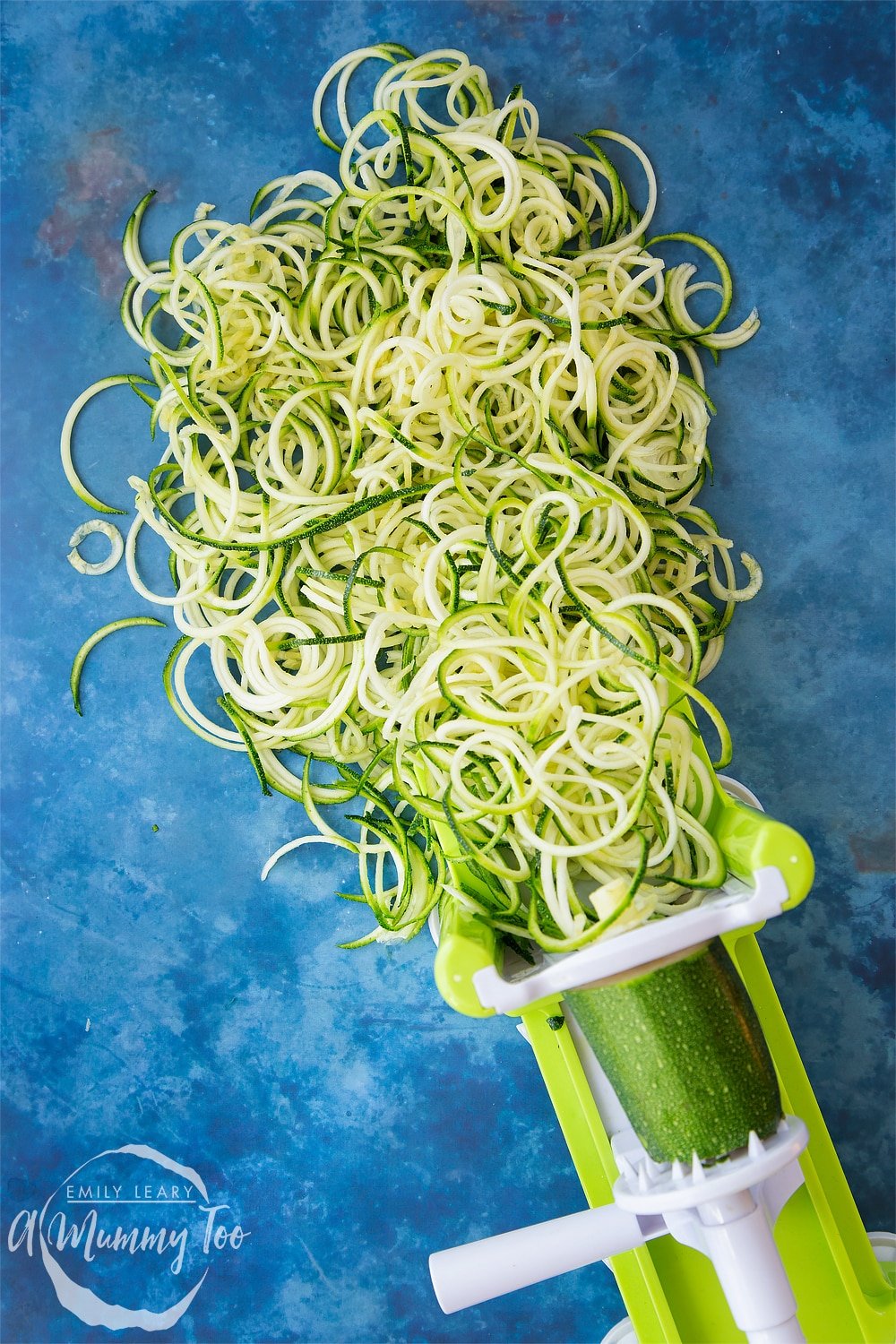
Print for later
And here's the courgette spaghetti recipe for you to print out. Let me know if you try it!
Annabel Karmel's Courgette Spaghetti (The Best Recipe I've Tried!)
Ingredients
- 4 courgette (zucchini) large
- 3 tbsp olive oil
- 2-3 cloves (2-3) garlic crushed
- 250 g (1¼ cups) fresh cherry tomatoes halved
- 2 tbsp fresh green pesto
- 50 g (½ cup) Parmesan or vegetarian hard cheese alternative grated/shredded
- pinch salt and black pepper
Instructions
- Put the courgettes through a spiraliser to make long spaghetti-like strands.
- Heat 2 tablespoons of the olive oil in a large frying pan over a medium heat.
- Add the garlic and fry for a few seconds, then add the spiralised courgettes to the pan.
- Toss over a high heat for 2-3 minutes, until just softening, then remove and set aside on kitchen paper.
- Return the frying pan to the heat, add the remaining olive oil, then fry the tomatoes for 2 minutes.
- Season, add the spiralised courgettes, pesto and grated Parmesan. Season, add the spiralised courgettes, pesto and grated Parmesan. Note from Emily: I find that I don’t always need all of the parmesan and pesto, so I would recommend adding half, stirring through and then adding the rest if needed.
- Toss until heated through and serve immediately.
Video
Nutrition
Recipe and photo reproduced with kind permission from Annabel Karmel / Ebury Publishing. Step by step photos shot by me, Emily Leary.
This post was originally published in 2016 and updated in 2019.
Pin Annabel Karmel's courgette spaghetti
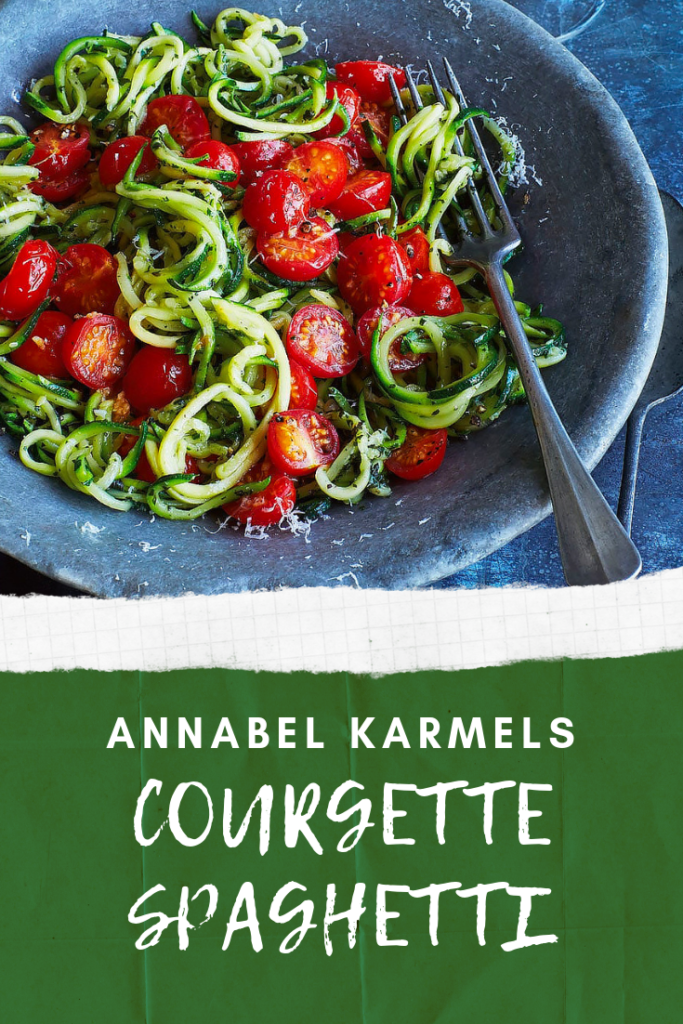
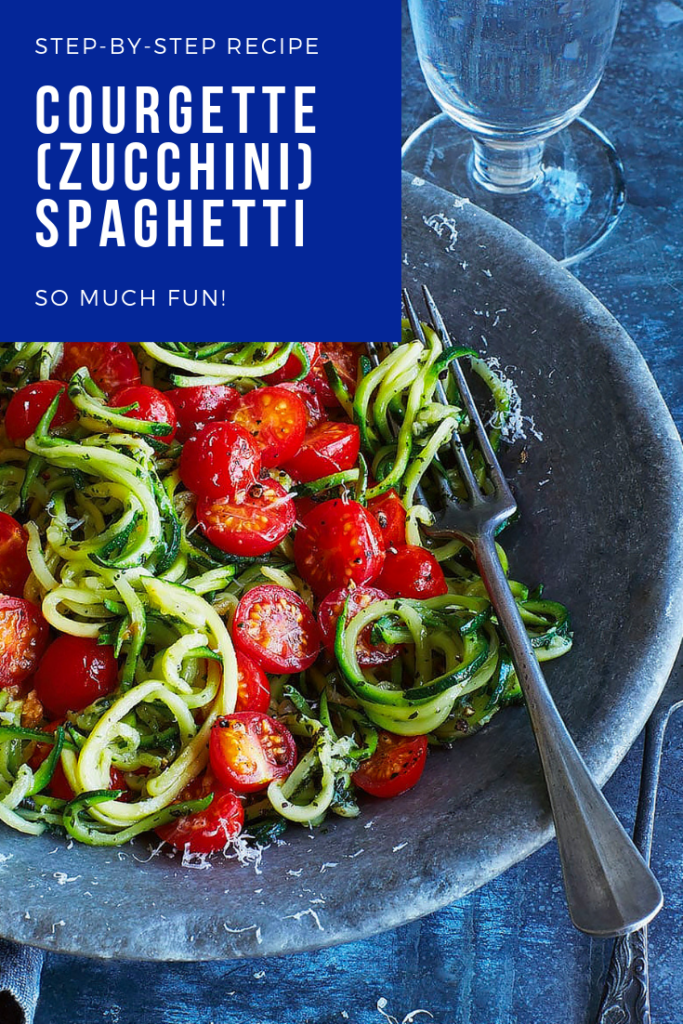
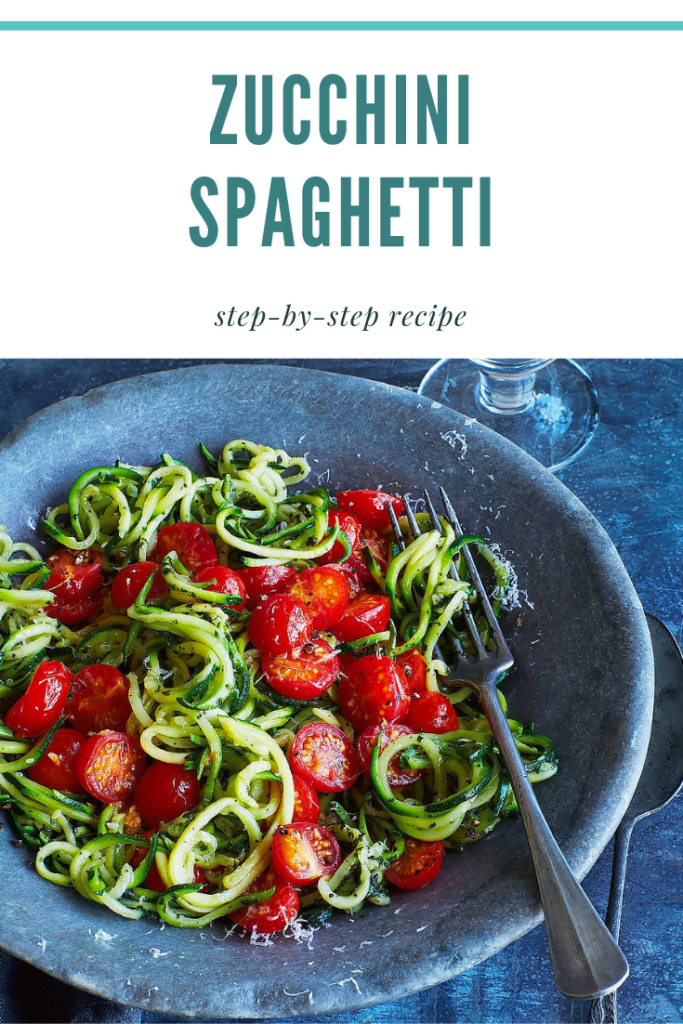
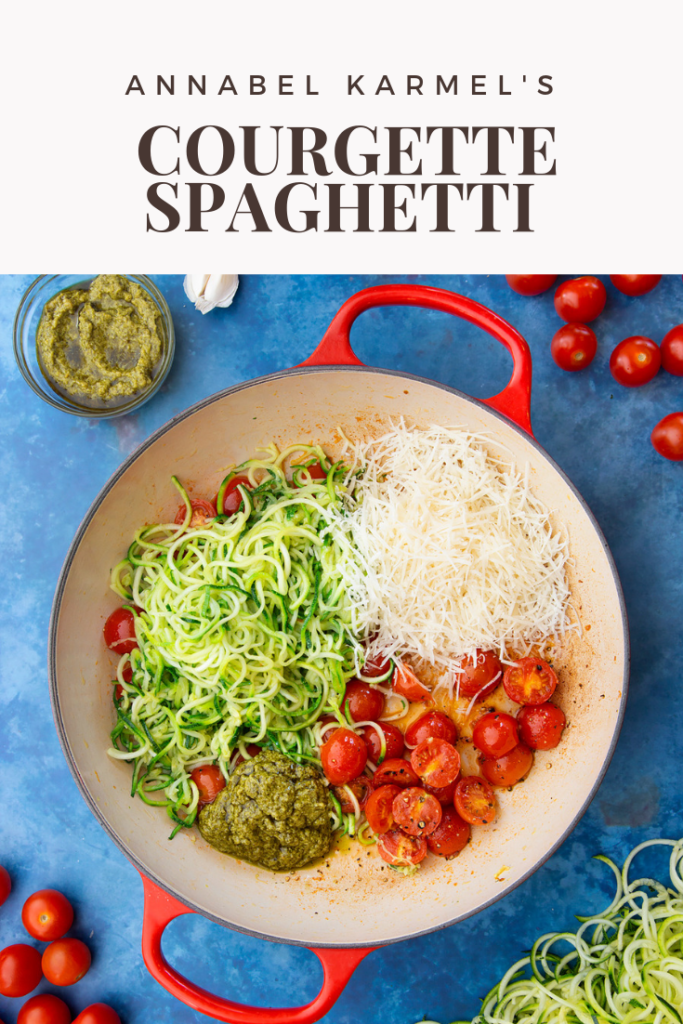
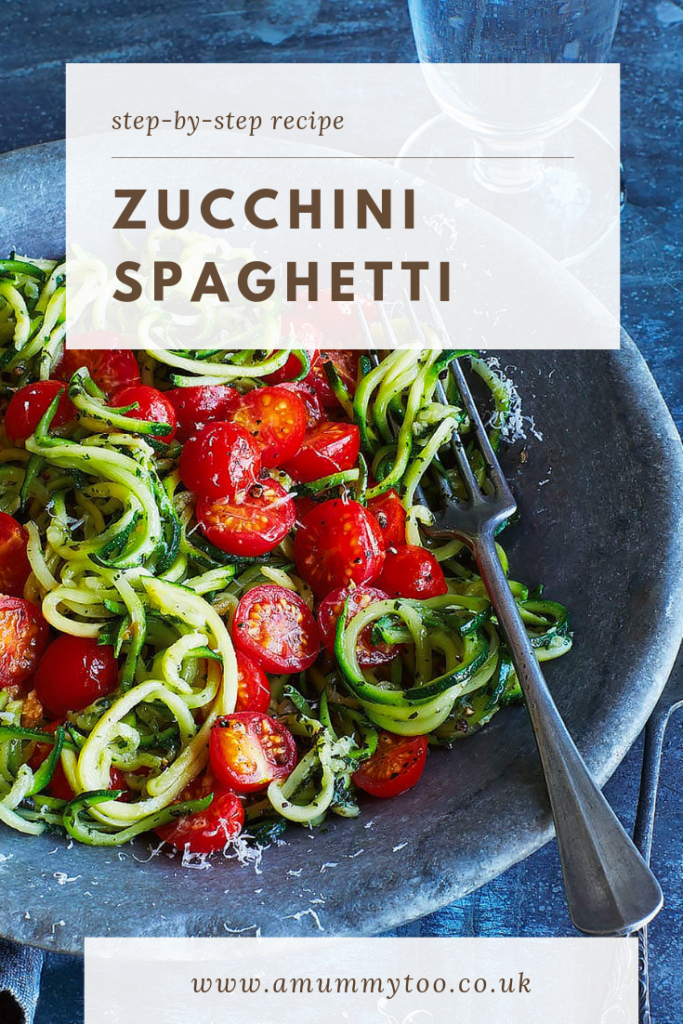
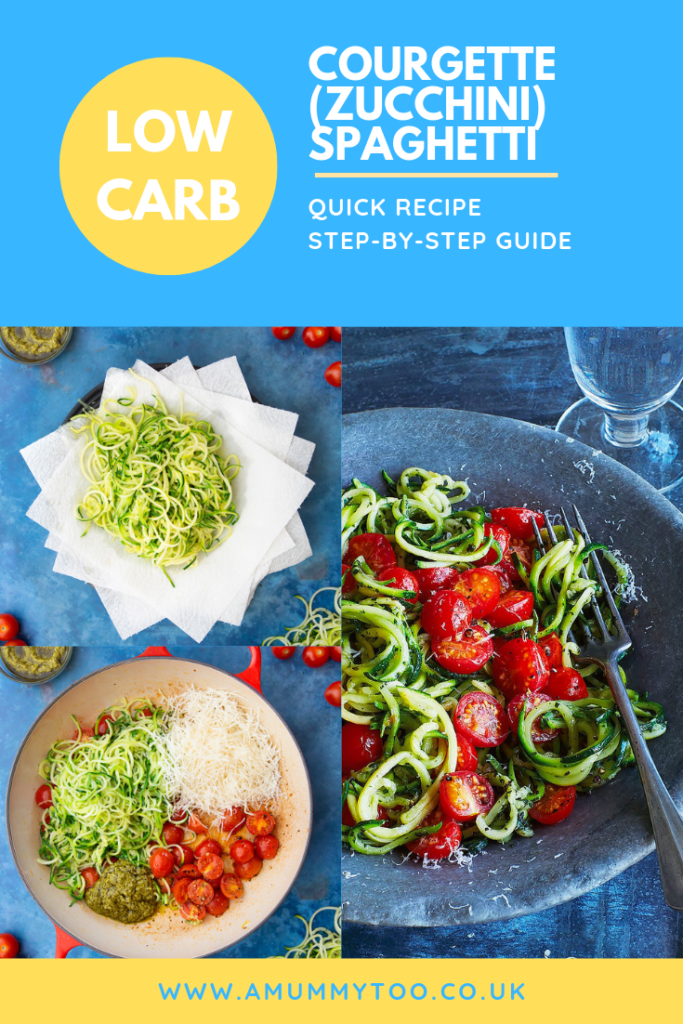
More courgette / zucchini recipes you'll love
Have you got my book?
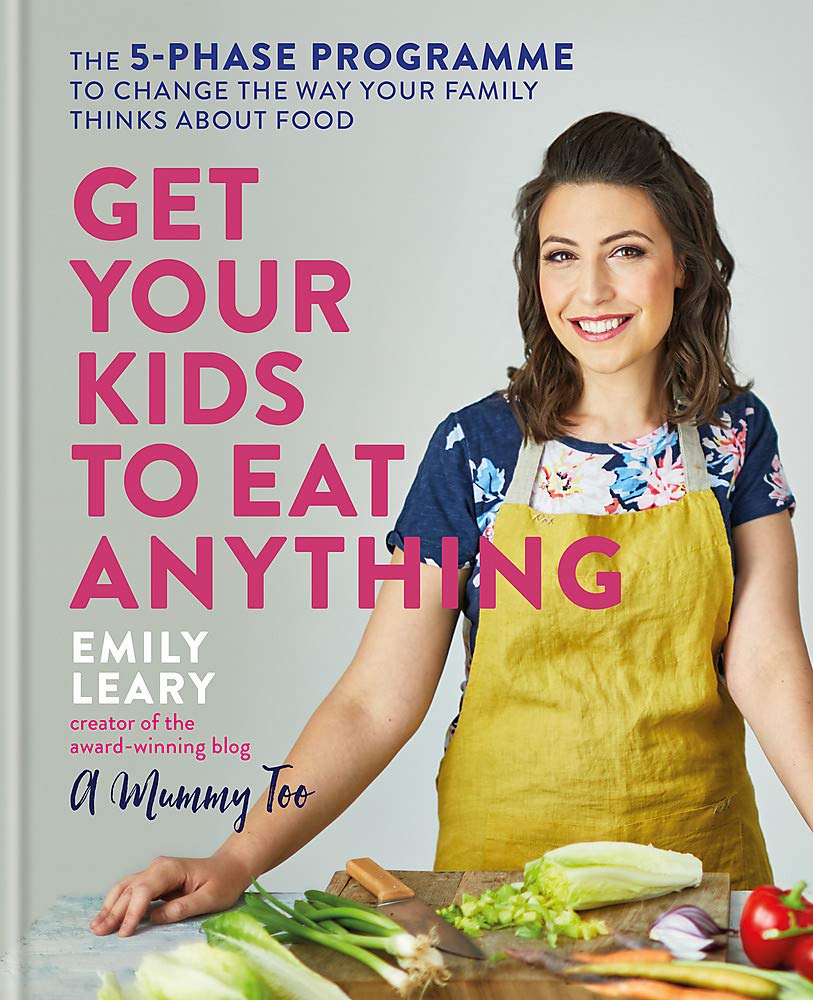
'This is a great kids cookery book. Emily is a star' - Simon Rimmer
'The book I'd like to force into any mother's kitchen' - Prue Leith
"A fab book with a plan." - Jane Devonshire, 2016 Masterchef UK winner
'Emily has managed to combine her mummy knowledge and passion for food to make a truly helpful and brilliant cookbook' - Priya Tew, RD, BSc (Hons), Msc
Get Your Kids to Eat Anything is an achievable 'how to' for parents in the battle to overcome picky eating and 'make new the norm'. Emily Leary's unique 5-phase programme looks at the issue of 'fussy eating' in a holistic way that links imagination with food, and which situates parents alongside - not in opposition to - their children.

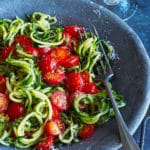
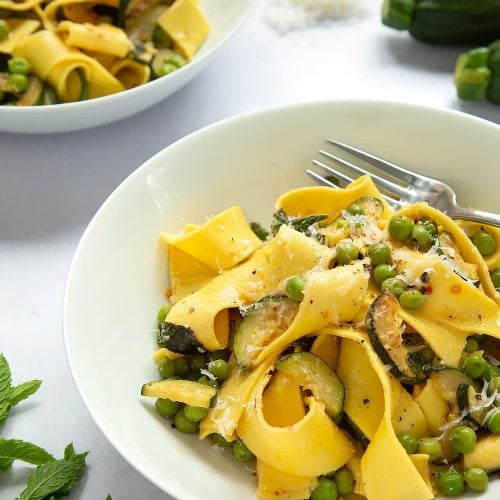
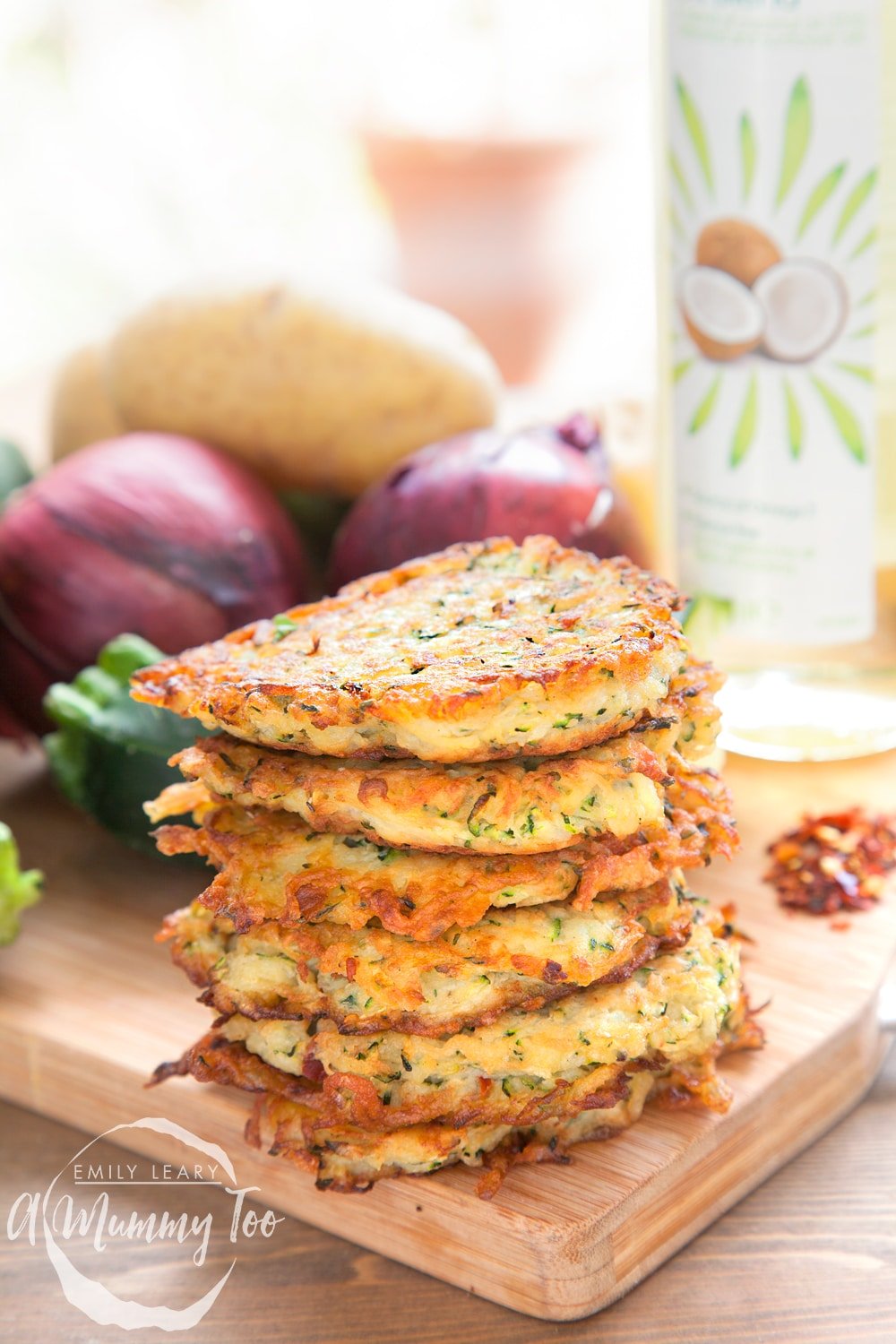
Lois says
Must admit I'm living off this recipe, adding little twists as I go along. Thank you so much for posting this.
Carlos says
Let me just say that the smoke point of olive oil isnt really the best so it should NOT be cooked at high heat.
The more extra virgin it is, the higher the smoke point but still, if you wanna cook high heat use avocado oil and maybe add the oilive oil in the end on the top before serving so you have the taste and you didnt heat it up. This way you are preventing free radicals formation from oxidative stress (from heating the olive oil to its smoke point)
Cheers
Emily Leary says
This is Annabel's recipe, but in my experience of cooking it, the oil really doesn't get hot as you only turn up the heat once you add the cold, bulky courgette and take it off soon after when the courgette has melted. It doesn't get a chance to smoke.
Chloe Edges says
Kevin! I'm howling! Courgetti shall forever be know as Kevin in my life! The recipe looks great too!